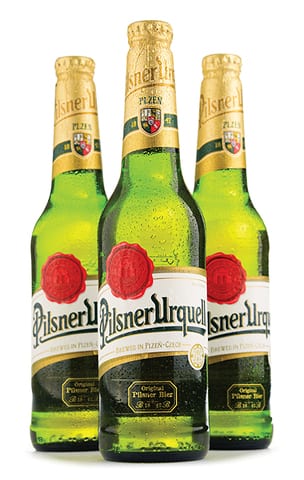The Dog Days of summer find many of us reaching for a lighter-bodied beer — one that’s refreshing and easy to drink, perhaps with a little less alcohol than our usual tipple, much like the lighter fare we might choose to enjoy during summertime meals.
If that’s the case with your hot-weather drinking habits, you owe a debt of gratitude to Bavarian brewmaster Josef Groll, who oversaw operations at the Citizens Brewery in Plzen, Bohemia (now part of the Czech Republic). The brewery had been started in 1839 as a project of the residents and city fathers of Plzen, who wanted to assure their fellow citizens that the beer brewed there would adhere to stricter standards than many other area breweries, whose beer had been so inconsistent that Czechs had poured barrels out into the streets the year before in protest.
By 1842, Groll had the opportunity to take advantage of a confluence of modern brewing developments never before available. Plzen was situated near several strategic rivers and other trade arteries, and Groll could source paler malts made possible through advances in malting technology, along with Bohemia’s world-class hops, specifically the noble Saaz variety, and the recently discovered lager yeast strain that had been smuggled out of Bavaria. The goal in Plzen was to brew Bavarian-style beers, hence Groll’s hiring. Using his prolific skills, Groll combined these ingredients to their utmost incarnation. Add to this recipe the remarkably soft water of the region, and Josef Groll created what would arguably become the most revolutionary beer style the world had ever seen, or ever would see: pilsener. On October 5 of that year (yes, we actually know the date!), after the barley harvest (and malting) and the later hops harvest, with a few months’ aging, the beer was rolled out to unanimous acclaim.
The Citizens Brewery eventually changed its name, after it registered the trademark in 1898 that would define the category forever: Pilsner Urquell, which translates roughly to “original pilsener.”
Early lager beers, including pilsener, required extended storage under colder conditions, unlike the ales of the day. Back then, cold storage required the coolness of caves to hold the aging beer, sometimes augmented with ice that had been cut from lakes and rivers in the winter and put away for the additional cooling necessitated by summer’s heat.
Another factor in the rise in popularity of pilsener beer was the mass production and subsequent affordability of glass drinking vessels by the masses, for the first time in history. The style’s unusual and striking golden color was now visible to everyone who raised a glass in the drinking halls and taverns.
Pilsener eventually became a game changer for every brewery on the planet. By 1853, the beer was available in 35 establishments in Prague, in 1856 it arrived in Vienna, and in 1862, Paris. It also is the style that took a firm hold on our shores once mechanical refrigeration became available on an industrial scale in the 1890s. This enabled American brewers to brew and age pilseners without underground storage, and it took mere decades for the style to dominate the American drinking scene.
Pilsener is one of the few beer styles that actually emphasizes every ingredient used in its makeup in the finished product: water, malt, hops, and yeast. Water quality is essential in very few brewing styles, and pilsener is one of them. Soft water adds to the drinkability of pilsener, and it is essential for the gentle yet persistent emphasis that hops play in both aroma and flavor, making pilsener the worldwide king of beer styles.
Classic pilseners remain the domain of the Czech Republic, and Bohemia specifically, but as the most-copied beer style in the world, they have been variously interpreted by others. Pilsener is likely the most popular style in neighboring Germany, where German hops play a slightly more significant role, and there are notable examples across Europe, from Poland to the Netherlands.
American pilsener was traditionally brewed with a portion of corn in the mash, as corn is more readily available and less expensive here than barley malt. This further lightened the resulting product, and it became the predominant style in the US, even up to this day. After World War II, the presence of hops in our iteration was gradually reduced to keep pace with the increasingly bland preferences of the American public, and the style here became a watered-down version, hardly recognizable as pilsener, with a few regional exceptions.
Though purists turn up their noses at what the style eventually became here, it has now been embraced by the craft-brewing community nationwide as a popular summer seasonal, if not a solid year-round offering. Now you can belly up to the bar in a lot of places and have yourself a “real” pilsener.
When you do, you’ll be sipping part of the 174-year history of pilsener beer, the skill of its creator, Josef Groll, and that of your local brewer, who has come to understand and respect the importance of the world’s most influential beer style, ever. Prost!
Author’s note: the spelling of pilsener has become a bit contentious, with variants such as pilsner, pilsen, or simply pils holding sway for others. I use the American precraft brewing-era spelling as homage to my dad, who for 35 years helped to brew Stoney’s pilsener beer at the Jones Brewing Company in Smithton, on the banks of Western Pennsylvania’s beautiful Youghiogheny River, where as a kid I first gained my love of beer and brewing. Thanks, Dad!



